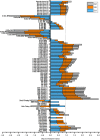An optimal filter for short photoplethysmogram signals
- PMID: 29714722
- PMCID: PMC5928853
- DOI: 10.1038/sdata.2018.76
An optimal filter for short photoplethysmogram signals
Abstract
A photoplethysmogram (PPG) contains a wealth of cardiovascular system information, and with the development of wearable technology, it has become the basic technique for evaluating cardiovascular health and detecting diseases. However, due to the varying environments in which wearable devices are used and, consequently, their varying susceptibility to noise interference, effective processing of PPG signals is challenging. Thus, the aim of this study was to determine the optimal filter and filter order to be used for PPG signal processing to make the systolic and diastolic waves more salient in the filtered PPG signal using the skewness quality index. Nine types of filters with 10 different orders were used to filter 219 (2.1s) short PPG signals. The signals were divided into three categories by PPG experts according to their noise levels: excellent, acceptable, or unfit. Results show that the Chebyshev II filter can improve the PPG signal quality more effectively than other types of filters and that the optimal order for the Chebyshev II filter is the 4th order.
Conflict of interest statement
The authors declare no competing interests.
Figures





References
Data Citations
-
- Liang Y., Liu G., Chen Z., Elgendi M. 2017. figshare. https://doi.org/10.6084/m9.figshare.5459299.v2 - DOI
References
-
- Zhou C., Feng J., Hu J. & Ye X. Study of Artifact-Resistive Technology Based on a Novel Dual Photoplethysmography Method for Wearable Pulse Rate Monitors. J. Med. Sys 40, 56 (2016). - PubMed
-
- Lochner C. M., Khan Y., Pierre A. & Arias A. C. All-organic optoelectronic sensor for pulse oximetry. Nature communications 5, 5745 (2014). - PubMed
Publication types
MeSH terms
Associated data
LinkOut - more resources
Full Text Sources
Other Literature Sources

